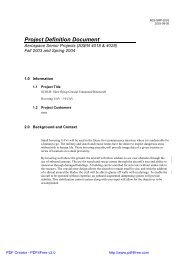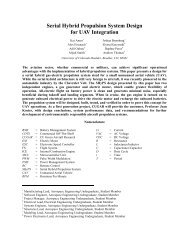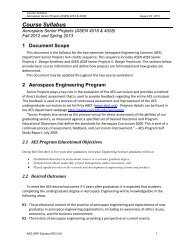PFR - Aerospace Engineering Sciences Senior Design Projects ...
PFR - Aerospace Engineering Sciences Senior Design Projects ...
PFR - Aerospace Engineering Sciences Senior Design Projects ...
Create successful ePaper yourself
Turn your PDF publications into a flip-book with our unique Google optimized e-Paper software.
Project Final Report – CUDBF April 30 th , 2009<br />
ASEN 4028: <strong>Aerospace</strong> <strong>Senior</strong> <strong>Projects</strong><br />
12.0 Fabrication and Integration<br />
Author: Jarryd Allison<br />
Co-Authors: Mark Findley, Eric Hall<br />
12.1 Interior Sub-Assembly<br />
Figure 106: Interior Landing Gear and Joiner Plate Assembly<br />
To begin building the aircraft multiple interior subsystems needed to be built in tandem in order<br />
to integrate these systems into the wing. The nose gear was started by first cutting a 10 inch<br />
section of aluminum T-bar. Once cut, all sharp edges were filed down and the end corners<br />
rounded to ease assimilation into the wing halves. A hole sized to fit the steering servo was cut<br />
into the aluminum bar, and to reduce weight, holes were drilled one inch apart long the shorter<br />
perpendicular section of the aluminum bar. The servo was set into the T-bar and secured by<br />
drilling holes into the aluminum bar at the appropriate locations. The COTS landing gear system<br />
(to include servo connection arm, hard plastic holders, and spar) was then installed into the<br />
aluminum bar by drilling holes into the aluminum which holds the spar holders via four small<br />
screws. The spar was then sent through the holders and held in place with the servo connection<br />
arm. The COTS landing gear was then attached to the servo and the system tested using the<br />
transmitter.<br />
The PIC microcontroller was built to attach to the receiver and control all avionics systems of the<br />
aircraft as well as the release mechanisms. Once the PIC was selected, code was written for the<br />
microcontroller and tested with the PIC on a breadboard. Once the breadboard prototype was<br />
completed, a circuit board was designed to house all of the necessary electronic components in a<br />
compact fashion, so it could easily be integrated into the plane. The components were soldered<br />
onto the circuit board and the microcontroller tested to ensure that all connections were secure.<br />
Each release mechanism consisted of a Trufire bow release trigger held in place using small<br />
sections of aluminum L-bar. To alter the triggers, the hand grip was removed on the band saw<br />
and the screws that hold the two halves of the system together also removed. The screw holes<br />
were then extended using a drill and the release trigger bolted to the aluminum holders. In the<br />
actual releasing part of the system, the spring was manipulated by installing a small screw into<br />
124
















